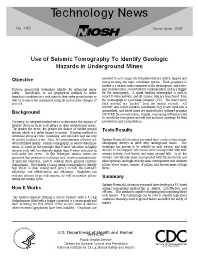Mining Publication: Technology News 466 - Use of Seismic Tomography to Identify Geologic Hazards in Underground Mines
Original creation date: November 1997
The use of seismic tomography to identify geologic hazards in underground mines was discussed. Problems associated with determining the amounts of relative stress in large rock pillars in deep underground mines were summarized. No adequate method for determining these types of stressors currently exists. Existing methods for determining geological stress are time consuming and expensive and can only be used in localized areas and frequently produce data of limited quality. Seismic tomography as applied to determining stress is based on the principle that P-wave velocities in highly stressed rock will be relatively higher than in rock under less strain. Seismic tomography involves generating seismic waves that penetrate rock masses. Measurements of the apparent velocities of the P-waves can be used to construct stress gradient contours (tomograms). The method involves striking a source location with a 4.5 kilogram sledge hammer that has been fitted with a trigger connected to a seismograph and then recording the first arrival of the seismic wave at stations where receivers (geophones) are located. Each geophone is linked to a seismic cable connected to a signal stacking seismograph. The seismograph records all P-wave arrivals. All P-wave data are transferred from the seismograph to a personal computer which produces tomograms with the aid of the software program 3DTOM. The results of seismic tests conducted by the Spokane, Washington, Research Laboratory (SRL) were discussed. SRL personnel have conducted seismic tomography surveys at three deep underground mines. Areas of high stress in the mapped rock masses could be correlated with later seismic activity, rock bursts, and major ground falls. In all three surveys, low P-wave velocity areas corresponded with fractured rock and mine openings. High velocity areas were found to correspond to unmined pillars above stopes, corners of pillars, and known areas of high stress. It was concluded that seismic tomography represents a reliable, cost effective and efficient method for evaluating stress in large rock masses and monitoring stress in pillars during mining cycles.
Authors: DF Scott, TJ Williams
Technology News - November 1997
NIOSHTIC2 Number: 00241857
U.S. Department of Health and Human Services, Public Health Service, Centers for Disease Control and Prevention, National Institute for Occupational Safety and Health, Technology News 466, 1997 Nov; :1-2
See Also
- Advanced Mining Seismicity Processing
- Performance and Safety Investigation of Emergency Backup Batteries and Battery Charging Systems for Underground Mining Applications
- Practical Risk Assessment Guidelines for Identifying, Assessing, and Mitigating Stored Energy Hazards in Underground Coal Mines During and After a Mine Emergency
- Refuge Alternatives in Underground Coal Mines
- Relationship Between Radiated Seismic Energy and Explosive Pressure for Controlled Methane and Coal Dust Explosions in an Underground Mine
- Rock Damage Characterisation from Microseismic Monitoring
- Safe and Economical Inerting of Sealed Mine Areas
- Technology News 514 - The Air Quantity Estimator (AQE): A New Computer Software Tool for Large-opening Mine Ventilation Planning
- Ultra-Low Frequency Through-the-Earth Communication Technology
- Wireless Mesh Mine Communication System
- Content source: National Institute for Occupational Safety and Health, Mining Program


 ShareCompartir
ShareCompartir
